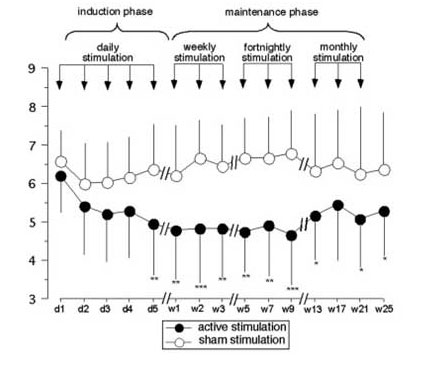
Pain, whether caused by a bulging disc in the spine, arthritis in the knee, nerve damage, or another condition, is ultimately processed in the brain. When an injury or illness occurs, nerve pathways transmit pain signals from the affected area to the spinal cord and brain, where the sensation of pain is consciously experienced.
However, in chronic pain conditions, these neural pathways can become overactive, misfiring pain signals even after the original injury has healed. This can lead to persistent, debilitating pain that is difficult to manage with traditional treatments. Transcranial Magnetic Stimulation ( (TMS) offers a non-invasive, drug-free approach to reducing pain perception by modulating the brain’s neural activity.
While these methods can be effective, they don’t always address the brain’s role in chronic pain. TMS takes a “top-down” approach, directly targeting the neural networks involved in pain processing to help the brain regulate and reduce the intensity of pain signals.
TMS is FDA-approved for depression, but growing scientific evidence supports its effectiveness in treating chronic pain conditions, particularly:
For many patients, TMS helps lower pain levels, improve mood, and enhance overall quality of life, especially when traditional treatments have been ineffective.

When receiving TMS treatment for pain, about half of patients will experience significant reduction in pain (by one third or more). Benefit usually begins within several days of treatment and can last several months. Regular maintenance treatments can help the benefits last longer.
The graph shows the decrease in pain ratings (on a scale of 1-10, where 10 indicates more severe pain) over time in patients receiving real TMS treatment (black circles) compared to patients receiving sham or placebo TMS treatment (white circles), with benefit maintained even when treatments were spaced out to just once per month (A Mhalla et al, 2011).
Are you battling intractable pain that won’t subside? Mind Wave TMS offers the most effective Chronic pain therapy in Brisbane, providing a safe, powerful, and non-surgical alternative to drug therapy and surgery. Our advanced TMS treatment for chronic pain specifically targets the brain’s pain-processing centres, helping to reduce the severity of chronic pain signals.
Whether you’re suffering from fibromyalgia, nerve pain, or migraines, our clinic offers tailored chronic pain therapy in Brisbane designed to maximise your daily function and overall health. We understand the challenges of living with chronic pain, and our clinic is dedicated to providing the best possible care in a compassionate, supportive environment.
• Non-invasive: No surgery or medications—just advanced magnetic stimulation to alleviate chronic pain.
• Targeted treatment: Specifically targets the brain’s pain-processing centres, reducing pain signals.
• Personalised care: We tailor each treatment plan to meet your individual needs for maximum relief.
• Safe & effective: Proven to help manage and reduce chronic pain, improving your quality of life.
Start your path to healing today and experience the benefits of our innovative, drug-free pain management solution.

Empowering Minds, Transforming Lives.
Disclaimer – Mind Wave TMS
Mind Wave TMS provides TMS treatment for individuals seeking alternative options for mental health care. The information on this website is for educational purposes only and should not be considered medical advice. Always consult with your psychiatrist or healthcare provider to determine if TMS is right for you.
If you are in crisis, seek immediate medical attention or contact a crisis helpline: